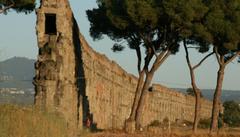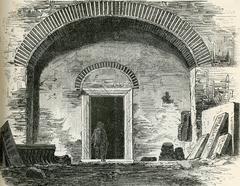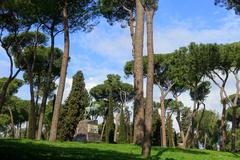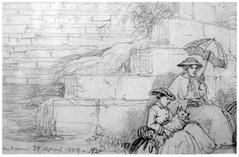Comprehensive Guide to Visiting Capo di Bove, Grottaferrata, Italy
Date: 24/07/2024
Introduction
Villa Capo di Bove, an archaeological gem nestled along the historic Via Appia Antica in Rome, Italy, stands as a testament to the grandeur of ancient Roman architecture and culture. This site, renowned for its well-preserved thermal baths and its association with notable historical figures, offers visitors a unique glimpse into the luxurious lifestyle of the Roman elite. Owned by Herodes Atticus, a prominent Greek rhetorician and Roman senator, and his wife Annia Regilla, the estate exemplifies the opulence and architectural ingenuity of the time (Renato Prosciutto). Today, the site is an integral part of the Appia Antica Archaeological Park, attracting history enthusiasts and tourists alike who seek to explore the remnants of Rome’s illustrious past (Ostrich Trails). This guide aims to provide comprehensive information on visiting Villa Capo di Bove, including its historical significance, visitor tips, and nearby attractions.
Table of Contents
Historical Background
Roman Origins and Early Use
Villa Capo di Bove, located along the historic Via Appia Antica in Rome, dates back to the mid-2nd century AD, during the height of the Roman Empire. Recent excavations have uncovered a thermal complex, indicating that the site was initially used for bathing purposes. The thermal baths, a common feature in Roman villas, were constructed using advanced building materials and techniques, suggesting the villa’s importance and the wealth of its owners (Renato Prosciutto).
Ownership by Herodes Atticus and Annia Regilla
Historical evidence points to the villa being owned by Herodes Atticus and his wife, Annia Regilla. Herodes Atticus was a prominent Greek rhetorician and a Roman senator, while Annia Regilla was a wealthy Roman aristocrat. Their ownership is supported by the luxurious nature of the complex and the high-quality materials used in its construction (Renato Prosciutto).
Modifications and Continued Use
The villa underwent several modifications over the centuries, reflecting changes in its use and the needs of its occupants. Traces of later alterations indicate that the baths were in use until at least the 4th century AD. After the fall of the Roman Empire, the site continued to be used, albeit for different purposes, such as agricultural activities during the Middle Ages (Renato Prosciutto).
Post-Roman Era and Viticulture
In the 19th century, the villa was repurposed for viticulture due to the fertile land and favorable climate. This agricultural use continued until the mid-20th century, when the site began to attract archaeological interest and preservation efforts commenced (Renato Prosciutto).
Modern Restoration and Current Use
Today, Villa Capo di Bove has been fully restored and serves as a significant cultural and historical site. The villa and its gardens have been meticulously preserved, and the former dépendence now functions as a reception and information center for tourists exploring the Via Appia Antica. The site includes a small museum that showcases the excavations and provides insights into the villa’s history and the broader context of Roman life along the Via Appia Antica (Renato Prosciutto).
Archaeological Findings
Excavations at Villa Capo di Bove have revealed numerous Roman ruins, including ancient walls and black-and-white floor mosaics. These findings provide valuable insights into the architectural styles and decorative preferences of the Roman elite. The mosaics, in particular, are notable for their intricate designs and craftsmanship (Renato Prosciutto).
Restoration Efforts Post-World War II
After World War II, the villa underwent significant restoration efforts. Materials looted from other monuments along the Via Appia Antica were used to restore the structure, highlighting the challenges and complexities of preserving historical sites in a region with such a rich and tumultuous history (Renato Prosciutto).
Integration into the Appia Antica Archaeological Park
Villa Capo di Bove is now an integral part of the Appia Antica Archaeological Park, a protected area that encompasses several significant historical sites along the ancient Roman road. The park offers visitors a unique opportunity to explore the remnants of Rome’s past in a serene and picturesque setting (Ostrich Trails).
Visitor Information
Visiting Hours and Ticket Prices
Villa Capo di Bove is open to visitors from 10 am to 4 pm, with extended hours on Sundays from 10 am to 6 pm. The site is closed on January 1 and December 25. While entry to the archaeological site is free of charge, there is a small fee for accessing the museum. For the latest ticket prices and any special discounts, visitors are encouraged to check the official website.
Accessibility and Practical Information
The villa is located at Via Appia Antica, 222, in the Appio Pignatelli neighborhood of Rome. It is accessible by public transportation, with bus 660 serving the area. The site is wheelchair accessible, ensuring that all visitors can enjoy its historical and cultural offerings.
Special Events and Guided Tours
Throughout the year, Villa Capo di Bove hosts special events and guided tours that delve deeper into its rich history. These tours are often led by expert archaeologists and historians who provide unique insights and anecdotes. Visitors are advised to book these tours in advance through the official website.
Photographic Spots and Additional Tips
The villa offers numerous picturesque spots perfect for photography, especially the well-preserved mosaics and lush gardens. Visitors are encouraged to bring their cameras and capture the beauty of this historical site. Additionally, it is recommended to wear comfortable walking shoes and bring water, especially during the warmer months.
Nearby Attractions
Other Historical Sites along Via Appia Antica
The Via Appia Antica is home to several other historical sites worth exploring, including the Catacombs of San Callisto, the Tomb of Cecilia Metella, and the Circus of Maxentius. These attractions provide a broader context of ancient Roman life and are all within walking or cycling distance from Villa Capo di Bove.
FAQ
Common Visitor Questions
Q: What are the visiting hours for Villa Capo di Bove?
A: The site is open from 10 am to 4 pm, with extended hours on Sundays until 6 pm. It is closed on January 1 and December 25.
Q: Is there an entry fee for Villa Capo di Bove?
A: Entry to the archaeological site is free, but there is a small fee for accessing the museum.
Q: How can I get to Villa Capo di Bove?
A: The villa is accessible by public transportation, with bus 660 serving the area. It is located at Via Appia Antica, 222.
Q: Are there guided tours available?
A: Yes, guided tours led by expert archaeologists and historians are available and can be booked in advance through the official website.
Q: Can I take photos at Villa Capo di Bove?
A: Yes, photography is allowed, and the site offers numerous photo opportunities.
Conclusion
Villa Capo di Bove stands as a testament to the rich and varied history of Rome, from its origins as a luxurious Roman villa to its modern role as a cultural and historical site. The villa’s preservation and integration into the Appia Antica Archaeological Park ensure that its legacy will continue to be appreciated by visitors from around the world. To stay updated on the latest events and information, consider downloading the mobile app Audiala or following us on social media (Renato Prosciutto; MuViAppia).
References
- Renato Prosciutto. Villa Capo di Bove Rome. https://renatoprosciutto.com/villa-capo-bove-rome/
- Ostrich Trails. Appian Way Walk. https://www.ostrichtrails.com/europe/italy/appian-way-walk/
- Weird Italy. Facts, Images, History of the Appian Way. https://weirditaly.com/2021/05/24/facts-images-history-of-the-appian-way/
- MuViAppia. Archaeological Sites: Complesso di Capo di Bove. https://muviappia.it/en/archaeological-sites/complesso-di-capo-di-bove/







